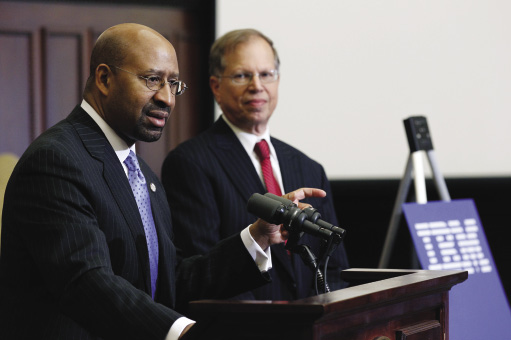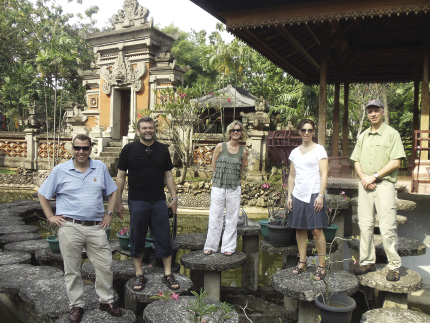- Home
- Media Kit
- Current Issue
- Past Issues
- Ad Specs-Submission
- Ad Print Settings
- Reprints (PDF)
- Photo Specifications (PDF)
- Contact Us

![]()
ONLINE


Philadelphia Mayor Michael A. Nutter (left) and
Stanley S. Litow announce workforce development
initiatives based on an IBM Smarter Cities
Challenge sponsored study
Building a
Smarter Planet
Editors’ Note
Prior to joining IBM, Stanley Litow served as the Deputy Chancellor of Schools for the City of New York; founded and ran Interface, a nonprofit think tank; and served as an aide to both the Mayor and the Governor of New York. He currently heads the global corporate citizenship efforts at IBM in more than 170 countries, and also chairs the Global Leadership Network and serves on the boards of the Harvard Business School’s Social Enterprise Initiative, the Citizens Budget Commission, and The After-School Corporation.
Company Brief
IBM Corporation (www.ibm.com) employs approximately 400,000 people worldwide and is a leading provider of computing software, hardware, and services, including software, mainframes and servers, storage systems, and peripherals. Its service arm accounts for more than half of its revenue, and it is one of the world’s largest providers of software and semiconductors.
How critical is community engagement to the culture of IBM and how do you drive it throughout the firm?

An IBM Corporate Service Corps team during
an engagement in Jakarta, Indonesia
Community consciousness and civic engagement is part of the company’s value system and has been for 100 years. It’s something to which the founders of the company, the Watsons, were strongly committed. As of late, it has been ramped up to a much higher level. It was not to elevate and expand citizen engagement or corporate responsibility as a separate add on to how the business functions; it was designed to integrate community consciousness into business strategy and to make society better as part and parcel of how you do business in the first place.
In the 1930s, IBM cooperated with the Roosevelt Administration to create the infrastructure behind social security. The Social Security Act was passed and Francis Perkins was the first female Cabinet appointment in the U.S. as Labor Secretary. However, the U.S. Government had no infrastructure to operate Social Security so it turned to IBM. On the 25th anniversary of Social Security, Perkins stated that there would not be Social Security without IBM. That is but one example of making a difference in society as part of how you do business. The same was true after President Kennedy announced the space program. NASA had never built a rocket and had no engineers or scientists in large enough numbers, so IBM moved into NASA as a joint public/private partnership effort to further that mission.
Today, IBM’s effort in building a smarter planet is involved in everything from new ways to use data analytics to figure out how to create a social safety net that works, to ways to use cloud computing to create disaster relief toolkits that people around the world can use to respond to natural disasters. These are elements of a broad-based endemic program of real shared value – business value, community value, and civic consciousness, and it’s how the company does business.
To celebrate IBM’s 100th anniversary, we asked our employees to engage in community service on a worldwide basis. Last June 15th , over 320,000 employees performed 3.2 million hours worth of community service involving 10 million people – that is the largest community service activity in history. Since that day, another million hours have been committed by our employees to continue the strong effort they created.
What we’re doing now is giving community service and philanthropy a 21st century model combining creativity and innovation to help make the planet smarter.
How do you put metrics in place to track impact?
In terms of assessment of the value of corporate responsibility, there are five metrics: one is recruitment and retention of top talent, because great talent defines a great company. If your corporate responsibility and citizenship programs help you markedly to recruit top talent and retain them, that is a real winner from a corporate standpoint. We look at how people who are engaged in our programs improved their skills and are more likely to complete their careers at IBM; we also look at how important the IBM Citizenship Program is in recruitment efforts.
Second is in the technology arena. When we develop a “disaster relief in a box” toolkit hosted on a cloud or use voice technology to teach people to read, we use our best technology and talent to accomplish that and we achieve intellectual capital that we can leverage for a host of our clients. When we develop a new patent in business analytics, it has an economic value not because you’re developing a product and selling it, but because you’re building patents and intellectual capital, which is the hallmark of what a great innovation company like IBM is all about.
Third is in the area of socially responsible investments. Two of the major rankings in the area of corporate responsibility, Ceres and Covalence, rank IBM number one out of 800 plus global companies. As a consequence of being rated the best, socially responsible investment funds increasingly recommend IBM to buyers. We like to think they buy for the balance sheet, but also for our CSR profile. Socially responsible investment funds control over a trillion dollars worth of assets.
The fourth area is in media coverage. You can calculate the value of free media coverage of a story about any one of the high-profile programs we do and then you can ascribe an economic value to it based upon which outlet it was in.
And finally, you can look at the effect of corporate responsibility on your overall brand value through branding studies that look at how much of that value has to do with corporate responsibility and citizenship.
We also use metrics to examine individual programs. We created World Community Grid to provide super computing power for cancer and AIDS research. We can tell you how much computer time we donated and we can track the research efforts on the AIDS or cancer study. We’re also involved in helping children learn to read and we can track results on that – how many children or non-literate adults benefitted. And if we have done a project on smarter cities, like helping St. Louis become a safer city, we can track the results there too.
So across cities and countries where we do business, there are specific project-related measures and then there are the overall five metrics we use to measure our corporate responsibility year to year.
Is it ever frustrating when the message on all the good corporations do doesn’t get out?
Historically, there have been periods in American history where corporate America got more credit than it deserved and others when it got significantly less. The same is true of government or the voluntary sector.
But you make a mistake if you look at a company’s philosophy and values or brand based upon a short-term cycle. To build a company that lasts for 100 years requires that you have a set of values that make sense and are willing to change everything but those values in order to initiate and sustain yourself over time. While some of the criticism of the private sector has some merit, if you spend a lot of time worrying about that, you’ll spend too little time figuring out how to create larger value and make yourself even better at your business and corporate responsibility.•